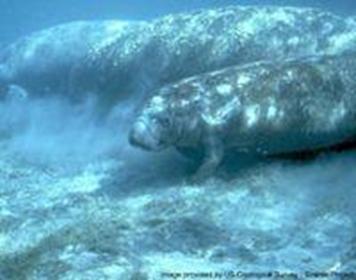


|
Sirenia:
Sirenia is an order of fully aquatic, herbivorous mammals that inhabit rivers, estuaries, coastal marine waters, swamps, and marine wetlands. The order evolved during the Eocene epoch, more than 50 million years ago. Sirenians, including manatees and the Dugong, have major aquatic adaptations: forelimbs have modified into arms used for steering, the tail has modified into a paddle used for propulsion, hindlimbs (legs) are but two small remnant bones floating deep in the muscle. They appear fat, but are fusiform, hydrodynamic, and highly muscular. Their skulls are highly modified for taking breaths at the water's surface and dentition is greatly reduced. They have only two teats, located under their forelimbs, similar to elephants. The three manatee species (family Trichechidae) and the Dugong (family Dugongidae) are endangered species. All four living species are vulnerable to extinction from habitat loss and other negative impacts related to human population growth and coastal development. Manatees and the Dugong are the only marine mammal classified as herbivores. Unlike the other marine mammals (dolphins, whales, seals, sea lions, sea otters, and walruses), sirenians only eat seagrasses and other aquatic vegetation. Unlike other marine mammals, sirenians have an extremely low metabolism and zero tolerance for cold water. Like dolphins and whales, manatees and the Dugong are totally aquatic mammals that never leave the water — not even to give birth. The combination of these factors means that sirenians are restricted to warm shallow coastal waters, estuaries, and rivers, with healthy ecosystems that support large amounts of seagrass and/or other vegetation. The Trichechidae species differ from Dugongidae in the shape of the skull and the shape of the tail. |
